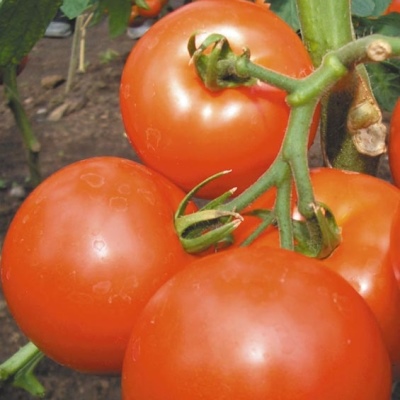
- Category: grade
- Growth type: determinant
- Appointment: fresh consumption, for pickling and preserving
- Ripening period: early
- Ripening time, days: 85-95
- Growing conditions: for open ground, for film greenhouses
- Bush size: undersized
- Bush height, cm: up to 50
- Ripe fruit color: red, no spot at the stalk
- Fruit shape: rounded
Apples in the snow are a tomato variety that can be highly appreciated by summer residents who want to get their first harvest as early as possible. In addition, these tomatoes have excellent taste and are undemanding to care for, they can be grown even in Siberia.
Description of the variety
The bush is of a determinant type, undersized, the height reaches 50 cm. The leafiness is medium, each cluster contains 5-7 fruits, in total 10-12 bunches are usually formed.
The main qualities of the fruit
The ripe fruit has a red color without a spot at the stalk, the size of the tomatoes is medium, the weight is 50-70 g, the tomatoes are round in shape.
Taste characteristics
The taste is classic, tomato, that is, sweet with a slight sourness. The pulp of the fruit is dense, but juicy, so excellent tomato juice is obtained from it. The skin is thin, so tomatoes are good for both fresh consumption and canning. Despite the thin skin, tomatoes can be stored for a long time without losing their taste.
Ripening and fruiting
Tomatoes Apples in the snow belong to varieties with an early ripening period, the first fruits ripen 85-95 days after germination. Harvesting is usually in July-August.
Yield
The variety is considered to be high yielding. Up to 3 kg of tomatoes can be removed from one bush, that is, about 35 fruits.
The timing of planting seedlings and planting in the ground
Sowing is done in March. A mixture of the following components is suitable as a substrate:
garden turf (2 parts);
sand (1 part);
peat (1);
compost (1).
For 10 kg of the resulting composition, add 25 g of fertilizer containing phosphorus and potassium, and wood ash (1 cup). To disinfect the substrate, it is treated with boiling water and potassium permanganate, and then sprinkled with "Fitosporin". Next, the seeds are buried 1 cm, the container is covered with a film and removed to a dark place. Growing seedlings in peat tablets is allowed.
When planting in a container, the film must be removed when the first shoots appear and the container must be placed in a lighted place. Seedling care consists in watering and feeding (three times). In the phase of 2-3 leaves, shoots should be dived. Start hardening the plants a week before transplanting. Take them outside, increasing your time outdoors every day. Disembarkation at the dacha is carried out at the end of May - beginning of June.

Growing tomato seedlings is an extremely important process, because it largely depends on whether the gardener can harvest at all. All aspects must be taken into account, from seedbed preparation to planting in the ground.
Landing scheme
Plant the shoots according to the 40x70 cm scheme. A closer planting can cause the spread of late blight. Cultivation is possible both in the open field and in a foil greenhouse. In addition, tomatoes have such an aesthetic appearance that some gardeners plant them on a windowsill or on a balcony. Lush bushes with colorful bunches become a real decoration of the home garden.
It is necessary to cultivate the plant in soil with neutral or weak acidity (pH 6.0-6.7). Sour soil needs to be limed, that is, add lime or dolomite flour to it.

Growing and caring
Leaving consists of the following steps.
Stepping out.
Garter for trellises.
Formation in 2-3 trunks.
Moderate watering (5-7 liters per plant).
Top dressing (complex mixtures, organic matter, superphosphates).
Mulching.




A plant needs different micronutrients at each stage of growth. All fertilizers can be divided into two groups: mineral and organic. Folk remedies are often used: iodine, yeast, bird droppings, eggshells.
It is important to observe the rate and period of feeding. This also applies to folk remedies and organic fertilizers.
Disease and pest resistance
The presented variety cannot boast of high immunity against late blight. As a preventive measure, remove weeds in a timely manner and ventilate the greenhouse. If the plants are already infected, then treat them with copper-containing preparations, remove and destroy all damaged areas.
Common insects are thrips, whitefly, aphids, spider mites. To prevent these pests, use a spraying with a weak solution of potassium permanganate. If insects have already attacked the crop, use insecticides. A more gentle remedy for aphids is a soap solution.



























































































